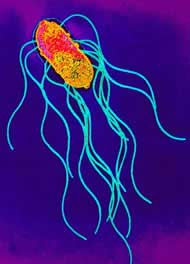Salmonella bacteria sequenced

Salmonella: two sequences are better than one <br>© SPL
Bugs behind typhoid and food poisoning give up genetic secrets.
Two teams have sequenced the genomes of two Salmonella bacteria. One is responsible for typhoid; the other causes food poisoning.
The genomes should lead to new ways to diagnose, treat and vaccinate against both diseases. Comparing the sequences should also clarify why the closely related bugs behave quite differently.
The two strains are called Typhi and Typhimurium. Typhi, the typhoid bug, infects only humans, attacking the liver, spleen and bone marrow. Gut-dwelling Typhimurium, a major cause of salmonella food poisoning, is much less fussy about where it sets up home. “It infects just about anything that walks or crawls on the face of the earth,” says microbiologist Stanley Maloy of the University of Illinois at Urbana-Champaign.
Fatal flaw
Typhoid infects 16 million people each year and kills 600,000. Drug resistance is making matters worse. The Typhi team sequenced a strain from Vietnam that is resistant to several antibiotics.
The genome data should improve diagnostic tools, says team member Gordon Dougan of Imperial College, London. Typhoid is hard to diagnose because its symptoms resemble those of other diseases, including malaria and dengue fever, and the bug is difficult to recognize.
Typhoid vaccines are not fully reliable, and are not included in infant vaccination programmes. “We need another step in vaccine progress,” says Dougan.
The rewards for such a step could be great. “If we could block its transmission in humans, we could eradicate it altogether – it’s got nowhere else to go,” says Julian Parkhill of the Sanger Centre in Cambridge, UK, leader of the Typhi genome project. Relying on human hosts has painted Typhi into an evolutionary corner.
Typhi’s genome gives a strong hint about its narrow tastes. The bacterium has more than 200 ’pseudogenes’ – once-functional stretches of DNA that have been inactivated by mutation. Working versions of these genes were discarded during Typhi’s evolution for its current habitat.
The more flexible Typhimurium, which presumably requires a bigger biological toolkit, has about 40 pseudogenes. Each bug also has hundreds of genes that are not found in the other. “For two organisms that are classified as a single species, the amount of difference is quite a surprise,” says Parkhill.
Problem and solution
Typhimurium has a less alarming public image, but is a bigger health problem than typhoid, says Michael McClelland of the Sidney Kimmel Cancer Center in San Diego, California, who led the project to sequence Typhimurium.
“It’s thought to be at least 30-fold underreported. There are probably hundreds of millions of cases every year in the world,” says McClelland. He adds that gut-dwelling Salmonella may kill twice as many people – mostly infants and the elderly – as typhoid.
Typhimurium’s sequence reveals 50 previously unknown genes that code for proteins on its surface. These are potential vaccine or drug targets.
The bug is a tool as well as a menace. Weakened versions are used to deliver vaccines and cancer drugs. In mice, Typhimurium’s symptoms are very similar to human typhoid, making it a laboratory favourite for salmonella research.
The team behind the Typhimurium genome has designed microchips to identify the genes that the organism switches on in different situations. These might explain how the bug lives in different hosts, and why it has different effects on humans and mice.
“It’s a double-whammy – we can design therapies and study Salmonella’s evolution,” says Typhimurium team member Sandra Clifton of Washington University in St Louis, Missouri.
There are more than 2,000 recognized strains of Salmonella enterica, with a wide variety of hosts and disease-causing capabilities. The genomes of several more strains are in the pipeline – comparisons between types “will provide the very best clues as to how [host switches] can happen in bacteria”, says Maloy.
References
- Parkhill, J. et al. Complete genome sequence of a multiple drug resistant Salmonella enterica serovar Typhi CT18. Nature, 413, 848 – 852, (2001).
- McClelland, M. et al. The complete genome sequence of Salmonella enterica serovar Typhimurium LT2. Nature, 413, 852 – 856, (2001).
Media Contact
All latest news from the category: Life Sciences and Chemistry
Articles and reports from the Life Sciences and chemistry area deal with applied and basic research into modern biology, chemistry and human medicine.
Valuable information can be found on a range of life sciences fields including bacteriology, biochemistry, bionics, bioinformatics, biophysics, biotechnology, genetics, geobotany, human biology, marine biology, microbiology, molecular biology, cellular biology, zoology, bioinorganic chemistry, microchemistry and environmental chemistry.
Newest articles

A ‘language’ for ML models to predict nanopore properties
A large number of 2D materials like graphene can have nanopores – small holes formed by missing atoms through which foreign substances can pass. The properties of these nanopores dictate many…

Clinically validated, wearable ultrasound patch
… for continuous blood pressure monitoring. A team of researchers at the University of California San Diego has developed a new and improved wearable ultrasound patch for continuous and noninvasive…

A new puzzle piece for string theory research
Dr. Ksenia Fedosova from the Cluster of Excellence Mathematics Münster, along with an international research team, has proven a conjecture in string theory that physicists had proposed regarding certain equations….



